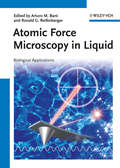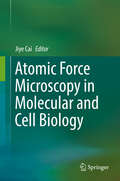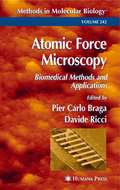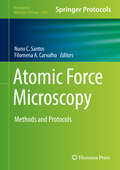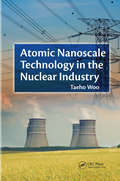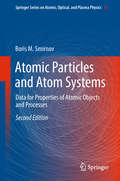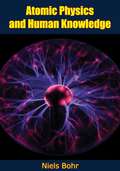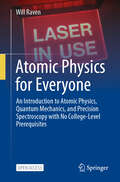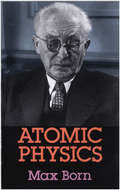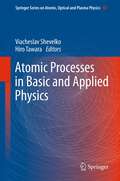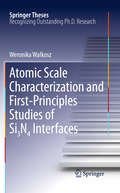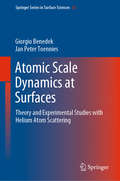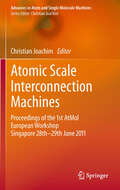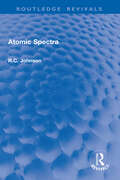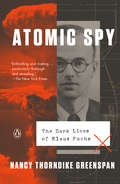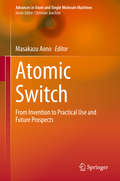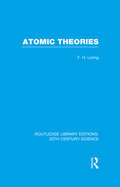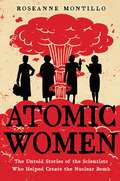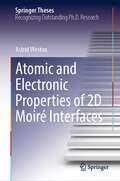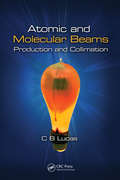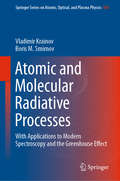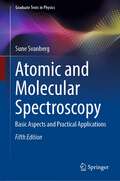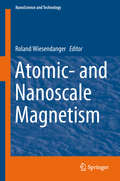- Table View
- List View
Atomic Force Microscopy in Liquid: Biological Applications
by Ulrich Prahl rer.nat. Georg J. SchmitzAbout 40 % of current atomic force microscopy (AFM) research is performed in liquids, making liquid-based AFM a rapidly growing and important tool for the study of biological materials. This book focuses on the underlying principles and experimental aspects of AFM under liquid, with an easy-to-follow organization intended for new AFM scientists. The book also serves as an up-to-date review of new AFM techniques developed especially for biological samples. Aimed at physicists, materials scientists, biologists, analytical chemists, and medicinal chemists. An ideal reference book for libraries. From the contents: Part I: General Atomic Force Microscopy * AFM: Basic Concepts * Carbon Nanotube Tips in Atomic Force Microscopy with * Applications to Imaging in Liquid * Force Spectroscopy * Atomic Force Microscopy in Liquid * Fundamentals of AFM Cantilever Dynamics in Liquid * Environments * Single-Molecule Force Spectroscopy * High-Speed AFM for Observing Dynamic Processes in Liquid * Integration of AFM with Optical Microscopy Techniques Part II: Biological Applications * DNA and Protein-DNA Complexes * Single-Molecule Force Microscopy of Cellular Sensors * AFM-Based Single-Cell Force Spectroscopy * Nano-Surgical Manipulation of Living Cells with the AFM
Atomic Force Microscopy in Molecular and Cell Biology
by Jiye CaiThe book addresses new achievements in AFM instruments – e.g. higher speed and higher resolution – and how AFM is being combined with other new methods like NSOM, STED, STORM, PALM, and Raman. This book explores the latest advances in atomic force microscopy and related techniques in molecular and cell biology. Atomic force microscopy (AFM) can be used to detect the superstructures of the cell membrane, cell morphology, cell skeletons and their mechanical properties.
Atomic Force Microscopy: Biomedical Methods and Applications (Methods in Molecular Biology #242)
by Davide Ricci Pier Carlo BragaHighly experienced physicians and biologists clearly explain the basic technical knowledge needed to use AFM and demonstrate its multifarious uses in biomedicine and the life sciences. The applications range widely from morphostructural analyses of cellular structures, to the investigation of subcellular structures, to functional investigations, and reveal a powerful new way of looking at biological samples. The methods clearly demonstrate the advantages of AFM over traditional life science microscopy, among them simultaneous very high magnification and resolution, minimal tissue and cell preparation, and the ability to obtain different views of the sample from a single data collection.
Atomic Force Microscopy: Methods And Protocols (Methods in Molecular Biology #1886)
by Nuno C. Santos Filomena A. CarvalhoThis book aims to provide examples of applications of atomic force microscopy (AFM) using biological samples, showing different methods for AFM sample preparation, data acquisition and processing, and avoiding technical problems. Divided into two sections, chapters guide readers through image artifacts, process and quantitatively analyze AFM images, lipid bilayers, image DNA-protein complexes, AFM cell topography, single-molecule force spectroscopy, single-molecule dynamic force spectroscopy, fluorescence methodologies, molecular recognition force spectroscopy, biomechanical characterization, AFM-based biosensor setup, and detail how to implement such an in vitro system, which can monitor cardiac electrophysiology, intracellular calcium dynamics, and single cell mechanics. Written in the highly successful Methods in Molecular Biology series format, chapters include introductions to their respective topics, lists of the necessary materials and reagents, step-by-step, readily reproducible laboratory protocols, and tips on troubleshooting and avoiding known pitfalls.Authoritative and cutting-edge, Atomic Force Microscopy: Methods and Protocols is useful for researchers at different stages, from newcomers to experienced users, interested in new AFM applications.
Atomic Nanoscale Technology in the Nuclear Industry (Devices, Circuits, and Systems)
by Taeho WooDevelopments at the nanoscale are leading to new possibilities and challenges for nuclear applications in areas ranging from medicine to international commerce to atomic power production/waste treatment. Progress in nanotech is helping the nuclear industry slash the cost of energy production. It also continues to improve application reliability and safety measures, which remain a critical concern, especially since the reactor disasters in Japan. Exploring the new wide-ranging landscape of nuclear function, Atomic Nanoscale Technology in the Nuclear Industry details the breakthroughs in nanoscale applications and methodologies that are revolutionizing power production, biotechnology, and material science. Developments in atomic nanoscale technology have given us the ability to: Use ion beams to Investigate and optimize radiation energy losses at the nanoscopic level Assess nanoscopic safety circumstances involved in a reactor failure Analyze characteristics of nuclear spacecraft operating in the nanogravity of deep space Evaluate light collection enhancement for digital X-ray detection Apply brachytherapy using radioisotopes for cancer therapy Treat nuclear waste at the nanoscopic level Use systems-thinking decision making to analyze financial progress of nanotech in the energy industry Assess safety (and safety management methods) for nuclear nanomaterials used in plant operations Representing a first step in multi-combinatorial research, this text incorporates advanced studies that use Monte Carlo and solid-state measurement (including radiation detection) methods. Researchers used these to demonstrate the potential to upgrade methods of radiation protection and nuclear reactor operation (safety, waste disposal, etc.). The author also addresses how we can use nanotechnology to address industrial concerns and enhance nuclear medicine techniques. He highlights several nanomaterial systems and devices to illustrate developments in this area. About the Author: Taeho Woo launched the specialized field of atomic multinology (interdisciplinary research of nuclear technology), which combines the application of information technology, biotechnology, and nanotechnology in the nuclear industry.
Atomic Particles and Atom Systems: Data for Properties of Atomic Objects and Processes (Springer Series on Atomic, Optical, and Plasma Physics #51)
by Boris M. SmirnovThis book presents physical units and widely used physical formulas, which are given together with conversion factors in various units. It includes frequently used atomic spectra and data for atoms, ions and molecules, as well as potential curves for diatomic molecules, and provides numerical parameters for transport phenomena in gases and plasmas. Further, the rate constants of a number of processes in atmospheric ionized air have been added to this second edition of the book. The numerical data has been selected from the information on atoms, atomic systems, atomic processes and models for atomic physics in this area, and the numerical parameters of atoms, ions and atom systems are included in periodical tables of elements.
Atomic Physics
by D.C.G JonesUsing the quantum approach to the subject of atomic physics, this text keeps the mathematics to the minimum needed for a clear and comprehensive understanding of the material. Beginning with an introduction and treatment of atomic structure, the book goes on to deal with quantum mechanics, atomic spectra and the theory of interaction between atoms and radiation. Continuing to more complex atoms and atomic structure in general, the book concludes with a treatment of quantum optics. Appendices deal with Rutherford scattering, calculation of spin-orbit energy, derivation of the Einstein B coefficient, the Pauli Exclusion Principle and the derivation of eigenstates in helium. The book should be of interest to undergraduate physics students at intermediate and advanced level and also to those on materials science and chemistry courses.
Atomic Physics and Human Knowledge (Dover Books On Physics Series #Vol. Iii)
by Niels BohrThis collection of articles, which were first published in 1958 and written on various occasions between 1932 and 1957, forms a sequel to Danish physician Niels Bohr’s earlier essays in Atomic Theory and the Description of Nature (1934).“The theme of the papers is the epistemological lesson which the modern development of atomic physics has given us and its relevance for analysis and synthesis in many fields of human knowledge.“The articles in the previous edition were written at a time when the establishment of the mathematical methods of quantum mechanics had created a firm foundation for the consistent treatment of atomic phenomena, and the conditions for an unambiguous account of experience within this framework were characterized by the notion of complementarity. In the papers collected here, this approach is further developed in logical formulation and given broader application.”
Atomic Physics for Everyone: An Introduction to Atomic Physics, Quantum Mechanics, and Precision Spectroscopy with No College-Level Prerequisites
by Will RavenThis open access textbook introduces beginning undergraduate students and high school students to the world of quantum mechanics and atomic spectroscopy. Requiring no previous knowledge of physics and no math beyond basic algebra and sines and cosines, this book focuses on concepts to make the excitement of atomic physics more accessible for learners than ever before. It comes replete with learning goals, exercises and solutions, and an optional experimental component, making this text readily adoptable for both the classroom and the undergraduate lab. The book takes the reader on a lively and engaging tour through topics at the forefront of current science, including photons, quantum numbers, atomic energy levels, some different spectroscopy techniques, electronic structure, atomic notation, angular momentum, hyperfine structure, isotope shifts, the strong force, an introduction to the Standard Model of Particle Physics, and more. This is an open access book.
Atomic Physics: 8th Edition
by Max BornFirst published in English in 1935, this classic treatment is well known to students and teachers of physics around the world. Since its original publication, Professor Born (Nobel laureate, 1954) continually updated the book to incorporate new developments in all branches of physics, particularly in the field of elementary particles. For this eighth edition he also wrote a new chapter on the quantum theory of solids.Contents include:Kinetic theory of gasesElementary particlesSpin of the electron and Paul's principleThe nuclear atomWave-corpusclesAtomic structure and spectral linesQuantum statisticsMolecular structureQuantum theory of solidsNuclear physicsOver 40 helpful appendixes, dealing with the mean square deviation, theory of relativity, electron theory, the Compton effect, Hamiltonian theory and action variables, atomic form factor, meson theory, van der Waals forces, and other topics supplement the main text. A bibliography and numerous figures and graphs further enhance the usefulness of Atomic Physics, which retains its value as a broad treatment of basic physics from the special perspective of a towering figure in the field.
Atomic Processes in Basic and Applied Physics (Springer Series on Atomic, Optical, and Plasma Physics #68)
by Hiro Tawara Viacheslav ShevelkoThe book is a comprehensive edition which considers the interactions of atoms, ions and molecules with charged particles, photons and laser fields and reflects the present understanding of atomic processes such as electron capture, target and projectile ionisation, photoabsorption and others occurring in most of laboratory and astrophysical plasma sources including many-photon and many-electron processes. The material consists of selected papers written by leading scientists in various fields.
Atomic Scale Characterization and First-Principles Studies of Si₃N₄ Interfaces (Springer Theses)
by Weronika WalkoszThis thesis presents results from a combined atomic-resolution Z-contrast and annular bright-field imaging and electron energy loss spectroscopy in the Scanning Transmission Electron Microscopy, as well as first principles studies of the interfaces between crystalline β--Si3N4 and amorphous (i) CeO2-x as well as (ii) SiO2 intergranular film (IGF). These interfaces are of a great fundamental and technological interest because they play an important role in the microstructural evolution and mechanical properties of Si3N4 ceramics used in many high temperature and pressure applications. The main contribution of this work is its detailed description of the bonding characteristics of light atoms, in particular oxygen and nitrogen, at these interfaces, which has not been achieved before. The atomic-scale information on the arrangement of both light and heavy atoms is critical for realistic modeling of interface properties, such as interface strength and ion transport, and will facilitate increased control over the performance of ceramic and semiconductor materials for a wide-range of applications.
Atomic Scale Dynamics at Surfaces: Theory and Experimental Studies with Helium Atom Scattering (Springer Series in Surface Sciences #63)
by Giorgio Benedek Jan Peter ToenniesExperimental advances in helium atom scattering spectroscopy over the last forty years have allowed the measurement of surface phonon dispersion curves of more than 200 different crystal surfaces and overlayers of insulators, semiconductors and metals. The first part of the book presents, at a tutorial level, the fundamental concepts and methods in surface lattice dynamics, and the theory of atom-surface interaction and inelastic scattering in their various approximations, up to the recent electron-phonon theory of helium atom scattering from conducting surfaces. The second part of the book, after introducing the experimentalist to He-atom spectrometers and the rich phenomenology of helium atom scattering from corrugated surfaces, illustrates the most significant experimental results on the surface phonon dispersion curves of various classes of insulators, semiconductors, metals, layered crystals, topological insulators, complex surfaces, adsorbates, ultra-thin films and clusters. The great potential of helium atom scattering for the study of atomic scale diffusion, THz surface collective excitations, including acoustic surface plasmons, and the future prospects of helium atom scattering are presented in the concluding chapters. The book will be valuable reading for all researchers and graduate students interested in dynamical processes at surfaces.
Atomic Scale Interconnection Machines: Proceedings of the 1st AtMol European Workshop Singapore 28th-29th June 2011 (Advances in Atom and Single Molecule Machines)
by Christian JoachimThis volume documents the first International Workshop on Atomic Scale Interconnection Machines organised by the European Integrated Project AtMol in June 2011 in Singapore. The four sessions, discussed here in revised contributions by high level speakers, span the subjects of multi-probe UHV instrumentation, atomic scale nano-material nanowires characterization, atomic scale surface conductance measurements, surface atomic scale mechanical machineries. This state-of-the-art account brings academic researchers and industry engineers access to the tools they need to be at the forefront of the atomic scale technology revolution.
Atomic Spectra (Routledge Revivals)
by R.C. JohnsonAtomic Spectra (1950) is an elementary account of the theory of the spectra of atoms and molecules. It offers a snapshot into the development of physics, chemistry and mathematics.
Atomic Spectroscopy and Radiative Processes (UNITEXT for Physics)
by Egidio Landi Degl'InnocentiThis book describes the basic physical principles of atomic spectroscopy and the absorption and emission of radiation in astrophysical and laboratory plasmas. It summarizes the basics of electromagnetism and thermodynamics and then describes in detail the theory of atomic spectra for complex atoms, with emphasis on astrophysical applications. Both equilibrium and non-equilibrium phenomena in plasmas are considered. The interaction between radiation and matter is described, together with various types of radiation (e. g. , cyclotron, synchrotron, bremsstrahlung, Compton). The basic theory of polarization is explained, as is the theory of radiative transfer for astrophysical applications. Atomic Spectroscopy and Radiative Processes bridges the gap between basic books on atomic spectroscopy and the very specialized publications for the advanced researcher: it will provide under- and postgraduates with a clear in-depth description of theoretical aspects, supported by practical examples of applications.
Atomic Spy: The Dark Lives of Klaus Fuchs
by Nancy Thorndike Greenspan"Nancy Greenspan dives into the mysteries of the Klaus Fuchs espionage case and emerges with a classic Cold War biography of intrigue and torn loyalties. Atomic Spy is a mesmerizing morality tale, told with fresh sources and empathy." --Kai Bird, author of The Good Spy and coauthor of American Prometheus: The Triumph and Tragedy of J. Robert OppenheimerThe gripping biography of a notorious Cold War villain--the German-born British scientist who handed the Soviets top-secret American plans for the plutonium bomb--showing a man torn between conventional loyalties and a sense of obligation to a greater good.German by birth, British by naturalization, Communist by conviction, Klaus Fuchs was a fearless Nazi resister, a brilliant scientist, and an infamous spy. He was convicted of espionage by Britain in 1950 for handing over the designs of the plutonium bomb to the Russians, and has gone down in history as one of the most dangerous agents in American and British history. He put an end to America's nuclear hegemony and single-handedly heated up the Cold War. But, was Klaus Fuchs really evil?Using archives long hidden in Germany as well as intimate family correspondence, Nancy Thorndike Greenspan brings into sharp focus the moral and political ambiguity of the times in which Fuchs lived and the ideals with which he struggled. As a university student in Germany, he stood up to Nazi terror without flinching, and joined the Communists largely because they were the only ones resisting the Nazis. After escaping to Britain in 1933, he was arrested as a German émigré--an "enemy alien"--in 1940 and sent to an internment camp in Canada. His mentor at university, renowned physicist Max Born, worked to facilitate his release. After years of struggle and ideological conflict, when Fuchs joined the atomic bomb project, his loyalties were firmly split. He started handing over top secret research to the Soviets in 1941, and continued for years from deep within the Manhattan Project at Los Alamos. Greenspan's insights into his motivations make us realize how he was driven not just by his Communist convictions but seemingly by a dedication to peace, seeking to level the playing field of the world powers.With thrilling detail from never-before-seen sources, Atomic Spy travels across the Germany of an ascendant Nazi party; the British university classroom of Max Born; a British internment camp in Canada; the secret laboratories of Los Alamos; and Eastern Germany at the height of the Cold War. Atomic Spy shows the real Klaus Fuchs--who he was, what he did, why he did it, and how he was caught. His extraordinary life is a cautionary tale about the ambiguity of morality and loyalty, as pertinent today as in the 1940s.
Atomic Switch: From Invention to Practical Use and Future Prospects (Advances in Atom and Single Molecule Machines)
by Masakazu AonoWritten by the inventors and leading experts of this new field, the book results from the International Symposium on “Atomic Switch: Invention, Practical use and Future Prospects” which took place in Tsukuba, Japan on March 27th - 28th, 2017. The book chapters cover the different trends from the science and technology of atomic switches to their applications like brain-type information processing, artificial intelligence (AI) and completely novel functional electronic nanodevices. The current practical uses of the atomic switch are also described. As compared with the conventional semiconductor transistor switch, the atomic switch is more compact (~1/10) with much lower power consumption (~1/10) and scarcely influenced by strong electromagnetic noise and radiation including cosmic rays in space (~1/100). As such, this book is of interest to researchers, scholars and students willing to explore new materials, to refine the nanofabrication methods and to explore new and efficient device architectures.
Atomic Theories (Routledge Library Editions: 20th Century Science)
by F.H. LoringSummarising the most novel facts and theories which were coming into prominence at the time, particularly those which had not yet been incorporated into standard textbooks, this important work was first published in 1921. The subjects treated cover a wide range of research that was being conducted into the atom, and include Quantum Theory, the Bohr Theory, the Sommerfield extension of Bohr’s work, the Octet Theory and Isotopes, as well as Ionisation Potentials and Solar Phenomena. Because much of the material of Atomic Theories lies on the boundary between experimentally verified fact and speculative theory, it indicates in a unique way how the future of physics was perceived at the time of writing. It thus throws into stark relief not only the immense advances made since the 1920s, but also, perhaps, highlights the importance of not rigidly adhering to a particular program of future discoveries.
Atomic Women: The Untold Stories of the Scientists Who Helped Create the Nuclear Bomb
by Roseanne MontilloBomb meets Code Girls in this nonfiction narrative about the little-known female scientists who were critical to the invention of the atomic bomb during World War II.They were leaning over the edge of the unknown and afraid of what they would discover there: Meet the World War II female scientists who worked in the secret sites of the Manhattan Project. Recruited not only from labs and universities from across the United States but also from countries abroad, these scientists helped in -- and often initiated -- the development of the atomic bomb, taking starring roles in the Manhattan Project. In fact, their involvement was critical to its success, though many of them were not fully aware of the consequences.The atomic women include:Lise Meitner and Irène Joliot-Curie (daughter of Marie Curie), who led the groundwork for the Manhattan Project from Europe;Elizabeth Rona, the foremost expert in plutonium, who gave rise to the "Fat Man" and "Little Boy," the bombs dropped over Japan;Leona Woods, Elizabeth Graves, and Joan Hinton, who were inspired by European scientific ideals but carved their own paths.This book explores not just the critical steps toward the creation of a successful nuclear bomb, but also the moral implications of such an invention. p.p1 {margin: 0.0px 0.0px 0.0px 0.0px; font: 13.0px Times}
Atomic and Electronic Properties of 2D Moiré Interfaces (Springer Theses)
by Astrid WestonThis thesis provides the first atomic length-scale observation of the structural transformation (referred to as lattice reconstruction) that occurs in moiré superlattices of twisted bilayer transition metal dichalcogenides (TMDs) at low (θ Studies using Scanning transmission electron microscopy (STEM), a powerful tool for atomic-scale imaging, were limited due to the complexity of the (atomically-thin) sample fabrication requirements. This work developed a unique way to selectively cut and re-stack monolayers of TMDs with a controlled rotational twist angle which could then be easily suspended on a TEM grid to meet the needs of the atomically thin sample requirements. The fabrication technique enabled the study of the two common stacking-polytypes including 3R and 2H (using MoS2 and WS2 as the example) as well as their structural evolution with decreasing twist-angle.Atomic-scale studies were followed by a comprehensive investigation of their electronic properties using scanning probe microscopy and electrical transport measurements of the artificially-engineered structures. The electronic structure of two common stacking-polytypes (3R and 2H) were strikingly different, as revealed by conductive atomic force microscopy. Further studies focused on the 3R-stacking polytype to reveal room-temperature out-of-plane ferroelectricity using tools such as kelvin probe force microscopy, scanning electron microscopy and electrical transport measurements. This work highlights that the unique intrinsic properties of TMDs (i.e. semiconductors with strongly light-matter interaction) combined with the additional twisted degree-of-freedom has great potential to create atomically thin transistors/LEDs with built-in memory storage functions and will further aid in the development of the next generation of optoelectronics.
Atomic and Molecular Beams: Production and Collimation
by Cyril Bernard LucasAtomic and molecular beams are employed in physics and chemistry experiments and, to a lesser extent, in the biological sciences. These beams enable atoms to be studied under collision-free conditions and allow the study of their interaction with other atoms, charged particles, radiation, and surfaces. Atomic and Molecular Beams: Production and Col
Atomic and Molecular Radiative Processes: With Applications to Modern Spectroscopy and the Greenhouse Effect (Springer Series on Atomic, Optical, and Plasma Physics #108)
by Boris M. Smirnov Vladimir KrainovThis book describes selected problems in contemporary spectroscopy in the context of quantum mechanics and statistical physics. It focuses on elementary radiative processes involving atomic particles (atoms, molecules, ions), which include radiative transitions between discrete atomic states, the photoionization of atoms, photorecombination of electrons and ions, bremsstrahlung, photodissociation of molecules, and photoattachment of electrons to atoms. In addition to these processes, the transport of resonant radiation in atomic gases and propagation of infrared radiation in molecular gases are also considered. The book subsequently addresses applied problems such as optical pumping, cooling of gases via laser resonance radiation, light-induced drift of gas atoms, photoresonant plasma, reflection of radio waves from the ionosphere, and detection of submillimeter radiation using Rydberg atoms. Lastly, topical examples in atmospheric and climate change science are presented, such as lightning channel glowing, emission of the solar photosphere, and the greenhouse phenomenon in the atmospheres of the Earth and Venus. Along with researchers, both graduate and undergraduate students in atomic, molecular and atmospheric physics will find this book a useful and timely guide.
Atomic and Molecular Spectroscopy: Basic Aspects and Practical Applications (Graduate Texts in Physics)
by Sune SvanbergA wide-ranging review of modern spectroscopic techniques such as X-ray, photoelectron, optical and laser spectroscopy, and radiofrequency and microwave techniques. On the fundamental side the book focuses on physical principles and the impact of spectroscopy on our understanding of the building blocks of matter, while in the area of applications particular attention is given to those in chemical analysis, photochemistry, surface characterisation, environmental and medical diagnostics, remote sensing and astrophyscis. The Fourth Edition also provides the reader with an update on laser cooling and trapping, Bose-Einstein condensation, ultra-fast spectroscopy, high-power laser/matter interaction, satellite-based astronomy and spectroscopic aspects of laser medicine.
Atomic- and Nanoscale Magnetism (NanoScience and Technology)
by Roland Wiesendanger<p>This book provides a comprehensive overview of the fascinating recent developments in atomic- and nanoscale magnetism, including the physics of individual magnetic adatoms and single spins, the synthesis of molecular magnets for spintronic applications, and the magnetic properties of small clusters as well as non-collinear spin textures, such as spin spirals and magnetic skyrmions in ultrathin films and nanostructures. <p>Starting from the level of atomic-scale magnetic interactions, the book addresses the emergence of many-body states in quantum magnetism and complex spin states resulting from the competition of such interactions, both experimentally and theoretically. It also introduces novel microscopic and spectroscopic techniques to reveal the exciting physics of magnetic adatom arrays and nanostructures at ultimate spatial and temporal resolution and demonstrates their applications using various insightful examples. The book is intended for researchers and graduate students interested in recent developments of one of the most fascinating fields of condensed matter physics.</p>
